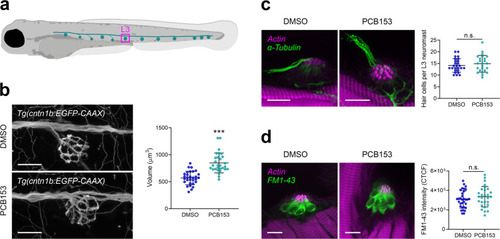|
Effect of PCB153 on morphology and function of lateral line hair cells and innervating neurons.a Diagram indicating L3 neuromast. b Hair cell innervating neurons at neuromast L3 shown using Tg(cntn1b:EGFP-CAAX) and volume of hair cell innervating neurons of DMSO (n = 30) and PCB153 (n = 29) treated larvae. Scale bar = 20 µm. c Whole-mount immunostaining of kinocilia and hair cell innervating neurons (anti-acetylated tubulin antibody; green) and counterstain of stereocilia bundles and muscle tissue (actin; magenta) of DMSO (n = 26) and PCB153 (n = 24) treated larvae. The hair cell number was determined based on the number of kinocilia. Scale bar = 10 µm. d Uptake of FM1-43 dye as indication of functional hair cells of DMSO (n = 32) and PCB153 (n = 28) treated larvae. CTCF = Corrected total cell fluorescence. Scale bar = 10 µm. All data points are biologically independent samples from three independent experiments and mean ± SD are shown in the plots. Unpaired two-tailed t-test with Welch’s correction was used for statistical analysis in (b, c), a two-way ANOVA accounting for trial and treatment in (d). Asterisks indicate significant differences to controls (***p < 0.001).
|

